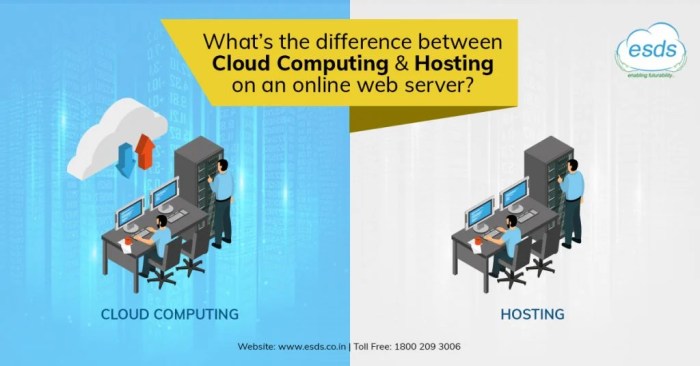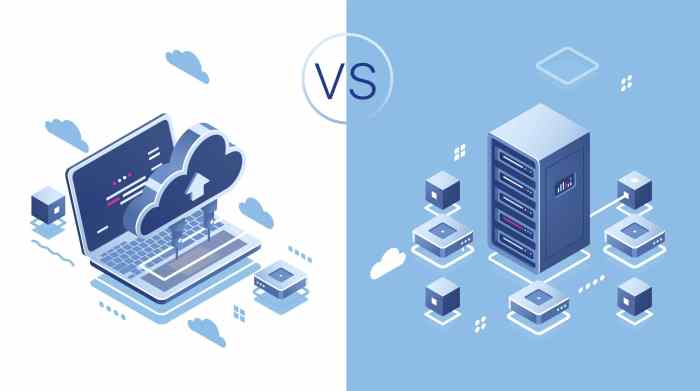Cloud computing vs web server: It’s a debate that’s been raging for years, and honestly, it’s not always an “either/or” situation. Think of it like choosing between a cozy apartment and a sprawling mansion – both have their perks, depending on your needs and budget. This deep dive explores the core differences between these two fundamental approaches to hosting applications and data, looking at scalability, security, cost, and ultimately, which one’s the right fit for your project.
We’ll unpack the cloud’s various service models (IaaS, PaaS, SaaS) and compare them to the world of dedicated web servers running Apache, Nginx, or IIS. Get ready to level up your tech knowledge!
We’ll be comparing apples and oranges, in a way. Cloud computing is a whole ecosystem, offering a range of services and flexible resource allocation. Web servers, on the other hand, are a specific piece of the puzzle – the software that handles requests and serves up websites and applications. Understanding their distinct roles and how they interact is key to making informed decisions about your tech stack.
We’ll cover everything from the nitty-gritty details of deployment and management to the long-term cost implications and security considerations. So buckle up, it’s going to be a wild ride!
Scalability and Resource Management

Cloud computing and traditional web servers offer vastly different approaches to scalability and resource management. Understanding these differences is crucial for choosing the right infrastructure for your application’s needs, especially as your project grows and evolves. This section will explore the key distinctions in scalability options, resource management techniques, and cost implications.
The core difference lies in the fundamental architecture. Traditional web servers rely on physical hardware, limiting scalability to adding more physical machines. Cloud computing, on the other hand, leverages a vast pool of virtual resources, allowing for near-limitless scalability on demand.
Scalability Options
Cloud computing provides several flexible scalability options. You can scale vertically (increasing resources like CPU, RAM, and storage on a single instance) or horizontally (adding more instances of your application). Auto-scaling features automatically adjust the number of instances based on real-time demand, ensuring optimal performance and resource utilization. Traditional web servers, however, require manual intervention to scale, involving purchasing, configuring, and deploying additional hardware—a process that can be time-consuming and expensive.
Resource Management Methods, Cloud computing vs web server
Cloud platforms offer sophisticated resource management tools, including monitoring dashboards, automated alerts, and resource allocation policies. These tools provide granular control over resource consumption, enabling optimization and cost savings. In contrast, managing resources on traditional web servers often involves manual monitoring of server logs, performance metrics, and resource utilization, requiring more hands-on management and expertise.
Cost Implications of Scaling
Scaling in the cloud typically follows a pay-as-you-go model, meaning you only pay for the resources you consume. This can be highly cost-effective for applications with fluctuating demand, as you only scale up when needed. Traditional web servers, however, involve upfront capital expenditure for hardware and ongoing maintenance costs, regardless of actual usage. Over-provisioning to handle peak demand leads to wasted resources and increased costs.
Under-provisioning, conversely, can result in performance bottlenecks and service disruptions.
Scenario: E-commerce Website During a Holiday Sale
Imagine an e-commerce website launching a massive holiday sale. With a traditional web server setup, anticipating the surge in traffic requires significant upfront investment in additional hardware. If the prediction is wrong, the company either suffers losses due to under-provisioning or faces excessive costs from over-provisioning. A cloud-based solution, however, would automatically scale up to handle the increased traffic, adding more instances as needed.
Once the sale ends, the cloud infrastructure automatically scales back down, minimizing costs. This dynamic scalability ensures optimal performance during peak demand while avoiding unnecessary expenses during off-peak periods.
Auto-scaling Examples in Cloud Environments
Amazon Web Services (AWS) utilizes Auto Scaling to dynamically adjust the number of EC2 instances based on predefined metrics, such as CPU utilization or request count. If CPU utilization exceeds a threshold, Auto Scaling automatically launches additional instances. Conversely, if utilization drops below a certain level, it terminates idle instances, optimizing resource usage and costs. Similar auto-scaling features are available in other cloud platforms like Google Cloud Platform (GCP) and Microsoft Azure, offering various metrics and scaling policies to meet diverse application needs.
For instance, a gaming server might scale based on concurrent player count, while a social media platform might scale based on tweet volume or user logins.
Cost Analysis and Return on Investment

Choosing between cloud computing and on-premise web servers involves a careful consideration of costs and the potential return on that investment. While upfront costs might seem lower for on-premise solutions, the long-term picture often favors the cloud, depending on your specific needs and scale. Let’s break down the financial aspects to help you make an informed decision.
Total Cost of Ownership (TCO) Comparison
The total cost of ownership (TCO) encompasses all direct and indirect costs associated with acquiring, deploying, and maintaining a system. For web servers, this includes hardware purchases, software licenses, infrastructure setup, maintenance, and IT staff salaries. Cloud computing, conversely, involves subscription fees, data transfer costs, and potentially additional services like managed databases or security features. A comprehensive comparison requires analyzing both short-term and long-term expenditures.
Factors Influencing Cost
Several factors significantly impact the cost of each option. For on-premise servers, initial hardware investment can be substantial, varying greatly based on the server’s processing power, storage capacity, and network capabilities. Ongoing maintenance, including hardware repairs and replacements, adds to the expense. Software licensing fees, IT staff salaries, and electricity costs also contribute significantly. In contrast, cloud computing costs are largely determined by usage.
You pay for the computing resources you consume, scaling up or down as needed. Data transfer charges, storage costs, and the selection of specific cloud services (like database management) all influence the overall cloud TCO.
Return on Investment (ROI) Analysis
The ROI for each option depends on numerous factors. For on-premise solutions, a high ROI is more likely if you have consistent, predictable workloads and require high levels of control and customization. The upfront investment pays off over time through consistent, predictable operational costs. However, this model is less flexible to scaling demands. Cloud computing’s ROI is typically driven by scalability and cost efficiency.
The ability to scale resources rapidly based on demand, pay-as-you-go pricing, and reduced management overhead can lead to significant cost savings, especially for businesses with fluctuating workloads or rapid growth.
Cost-Effectiveness Scenarios
Consider a small startup launching a new website. Cloud computing is likely the more cost-effective option. They can start with minimal resources and scale up as their user base grows, avoiding significant upfront investments in hardware. Conversely, a large enterprise with a mission-critical application requiring strict security controls and low latency might find an on-premise solution more cost-effective in the long run, even with higher initial costs.
In this topic, you find that cloud computing vs client server computing is very useful.
The guaranteed performance and control often outweigh the higher TCO.
Recurring and One-Time Costs Breakdown
| Cost Type | On-Premise Web Servers | Cloud Computing |
|---|---|---|
| One-Time Costs | Hardware purchase, initial software licenses, infrastructure setup | Initial setup fees (sometimes), potential migration costs |
| Recurring Costs | Electricity, maintenance, repairs, software updates, IT staff salaries, network bandwidth | Subscription fees, data transfer charges, storage costs, potential additional service fees |
Use Cases and Suitable Applications
Choosing between cloud computing and dedicated web servers depends heavily on the specific needs of your application. Factors like scalability requirements, budget constraints, and the technical expertise of your team all play a crucial role in making the right decision. This section will explore various application scenarios and highlight the advantages and disadvantages of each approach.
Cloud Computing Preferred Scenarios
Cloud computing shines when applications demand flexibility, scalability, and cost-effectiveness. Its pay-as-you-go model makes it ideal for projects with fluctuating resource needs or those experiencing unpredictable growth spurts. The inherent scalability of cloud platforms allows for seamless handling of traffic spikes without significant upfront investment in infrastructure.
Dedicated Web Servers Preferred Scenarios
Dedicated web servers offer greater control and customization, making them suitable for applications requiring stringent security, specific software configurations, or specialized hardware. They are a good choice when predictable, consistent performance is paramount, and the need for rapid scalability is minimal. This approach provides a higher degree of isolation and reduces the risk of resource contention with other users.
Application Examples: Cloud vs. Dedicated Web Servers
Let’s examine how the choice between cloud and dedicated servers plays out in different application contexts.
| Application Type | Suitable for Cloud | Suitable for Dedicated Web Server | Advantages (Cloud) | Advantages (Dedicated Server) |
|---|---|---|---|---|
| E-commerce | Yes | Maybe (for very large, established businesses with predictable traffic) | Scalability to handle peak shopping seasons, cost-effectiveness during off-peak times | Greater control over security and customization for sensitive transactions |
| Blogging | Yes | No (unless extremely high traffic is expected) | Ease of setup and management, automatic scaling based on traffic | Not applicable for typical blogs |
| Enterprise Applications (CRM, ERP) | Yes (often hybrid approach) | Maybe (for legacy systems or highly sensitive data) | Scalability, reduced IT overhead, improved collaboration | Enhanced security and control, potential for better performance for specific, known workloads |
Detailed Application Descriptions: Cloud-Suitable
Here are three applications well-suited for cloud deployment:
- Mobile Game Backend: Cloud computing allows for seamless scaling to accommodate fluctuating player numbers. As the game gains popularity, more server resources can be dynamically allocated without manual intervention. This ensures a smooth and responsive gaming experience for all players, regardless of the time of day or unexpected surges in concurrent users. The pay-as-you-go model also makes it cost-effective, especially during the game’s early stages.
- Social Media Platform: Social media platforms experience massive traffic spikes throughout the day. Cloud infrastructure provides the necessary scalability to handle these fluctuations, preventing outages and ensuring a consistent user experience. The ability to distribute resources across multiple data centers also improves resilience and minimizes downtime. The elasticity of cloud resources enables efficient resource utilization, optimizing costs based on actual usage.
- Machine Learning Model Deployment: Training and deploying machine learning models often require significant computing power. Cloud platforms offer access to powerful GPUs and specialized hardware, enabling faster training and more efficient model deployment. This also allows for easy scaling of model inference as the demand increases. The ability to easily manage and scale resources accelerates the entire machine learning lifecycle.
Detailed Application Descriptions: Dedicated Server-Suitable
These applications benefit from the control and predictability offered by dedicated servers:
- Financial Trading Platform: Low latency and high reliability are critical for financial trading applications. A dedicated server provides predictable performance and minimizes the risk of shared resource contention, ensuring fast and reliable execution of trades. The dedicated environment also enhances security, protecting sensitive financial data.
- Healthcare Data Management System: Stringent regulations like HIPAA require high levels of security and data protection. A dedicated server allows for better control over access, encryption, and data governance, ensuring compliance and patient privacy. The dedicated environment minimizes the risk of data breaches and unauthorized access.
- High-Security Government Website: Government websites often handle sensitive information requiring robust security measures. A dedicated server offers enhanced control over security configurations, firewalls, and access control lists, minimizing the risk of cyberattacks and data breaches. This approach ensures the confidentiality and integrity of government data.
Illustrative Examples

Choosing between cloud computing and dedicated web servers often depends on the specific needs of an application. Let’s examine two contrasting scenarios to illustrate the strengths of each approach. One example showcases a large-scale application thriving in the cloud, while the other highlights a small-scale application perfectly suited to a dedicated server.
Netflix’s Deployment on AWS
Netflix, a global streaming giant, relies heavily on Amazon Web Services (AWS) for its infrastructure. Their architecture is incredibly complex, but a simplified view involves a massive distributed system using various AWS services. Content is stored in S3 (Simple Storage Service), processed and encoded using EC2 (Elastic Compute Cloud) instances, and delivered via a global content delivery network (CDN) like CloudFront.
This allows them to handle billions of requests daily, serving content tailored to individual users’ preferences and bandwidth. The system is horizontally scalable, meaning they can easily add more EC2 instances and storage as needed to accommodate peak demand, such as during the release of a highly anticipated show. Challenges include maintaining data consistency across a distributed system, managing security across numerous services, and optimizing for low latency worldwide.
They overcame these challenges through robust monitoring, automation, and continuous integration/continuous deployment (CI/CD) pipelines. The benefits include unparalleled scalability, flexibility, and resilience, allowing Netflix to rapidly adapt to changing user demands and content volume. Resource allocation is dynamic, adjusting automatically based on real-time needs.
A Small E-commerce Site on a Dedicated Server
Imagine a small, local bakery launching an online ordering system. This business might choose a dedicated web server hosted at a colocation facility or through a managed hosting provider. The infrastructure is relatively simple: a single server running a web server (like Apache or Nginx), a database (like MySQL or PostgreSQL), and the e-commerce application itself. This setup offers a predictable and manageable environment.
The bakery’s needs are modest; they anticipate a relatively low volume of orders, and the server’s resources are sufficient. The simplicity reduces management overhead and initial costs. A major challenge could be handling unexpected spikes in traffic during holidays or promotional periods. They could mitigate this by implementing caching mechanisms and scaling vertically (upgrading to a more powerful server) if necessary, though this would involve downtime.
The cost-effectiveness is a significant advantage for a small business with limited resources. Resource allocation is fixed, requiring proactive planning for anticipated growth.
So, cloud computing or web servers? The answer, as with most things in tech, is “it depends.” After weighing the pros and cons of scalability, security, cost, and ease of management, you’ll be better equipped to choose the solution that best aligns with your specific needs and resources. Whether you’re building a small personal blog or a massive e-commerce platform, understanding the core differences between these two approaches is crucial for success.
Remember to factor in long-term scalability, security needs, and of course, budget constraints. Happy coding!
General Inquiries: Cloud Computing Vs Web Server
What are the main differences in maintenance between cloud and web servers?
Cloud providers handle most maintenance tasks, while web servers require manual updates, patching, and system administration.
Can I use both cloud computing and web servers together?
Absolutely! Hybrid approaches are common. You might use cloud services for scalability and a web server for specific, resource-intensive tasks.
Which is more secure, cloud or a web server?
Security depends on implementation. Both can be highly secure, but cloud providers often offer robust security features while web servers require diligent management.
What about downtime? Which is more reliable?
Cloud providers typically offer higher uptime guarantees through redundancy and failover mechanisms. Web servers rely on your own infrastructure’s reliability.